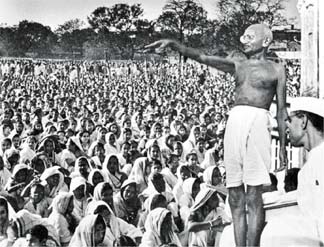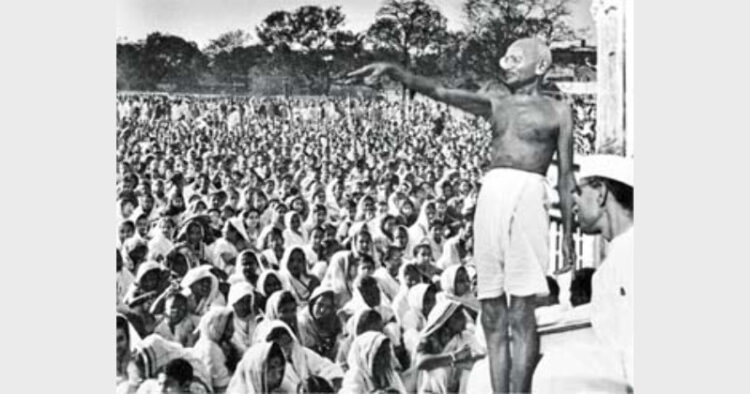 On 100th anniversary of Champaran Satyagrah, there is need for ‘genuine search for knowledge’ with use of methodologies that Gandhiji applied in Champaran and Nanaji Deshmukh conducted in Chitrakoot
On 100th anniversary of Champaran Satyagrah, there is need for ‘genuine search for knowledge’ with use of methodologies that Gandhiji applied in Champaran and Nanaji Deshmukh conducted in Chitrakoot
Siddheshwar Shukla Eklavy
We have grown up hearing and reading the age-old adage — “Real Bharat Lives in Villages”. The peasants are the real people who nourish, enrich and have been carrying the traditions through generations due to which the real Bharat pulsates in villages. After Independence, every Indian got freedom to use his property as per his wishes and decides the cost of his product but these two freedoms are not for peasants. Since decades, the Indian policymakers have been importing economic growth models from the West and appointing Western trained professionals to drive wheel of development. On the centenary of Champaran Satyagrah, the most successful peasant movement in modern India, it’s high time to turn the pages of our developmental history and think about “Real Bharat”.
Why is Champaran a landmark?
The first peasant movement against indigo farming occurred during the reign of Mughal Emperor Shahjahan, while the first successful movement against the combined problem of Indigo and Tibhaga was conducted in Bengal around 50 years before Gandhiji reached Champaran. Why did Champaran become the most successful peasant movement in modern India? How did it transform MK Gandhi into Bapu?
Indian peasants enjoyed an unparallel autonomy on their land until Islamic invaders defeated indigenous Kings and became rulers. The eminent historian Irfan Habib has described the peasant movements during the Mughal period which clearly indicates that the peasant movements were not just the phenomenon in modern India. For Indian peasants the agriculture land, cattle and nature are not mere source of livelihood but are integrated with their rituals and traditions related to birth, marriage, death, festivals, celebrations and decision making as well. Therefore, the Indian villages have been autonomous units based on the principles of sustainable development which has now been proclaimed as the supreme guiding principle for development by United Nations Organisation (UNO).
The first unique thing for Champaran was that Gandhiji did not jump on demands or recommendations. In his reply to Magistrate who ordered him to leave Champaran immediately, Gandhi wrote on April 16, 1917, “I must emphatically repudiate the Commissioner’s suggestion that my object is likely to start agitation. My desire is purely and simply for a genuine search for knowledge. And this I shall continue to satisfy so long as I am free”. Gandhiji himself met maximum people from peasants to women to factory owners to administrators in search of knowledge. The high level committee also went in this direction to get knowledge of peasants’ issues and their solutions directly from peasants and various stakeholders. This wide consultation integrated all and sundry of the region with the ‘movement’ which was never an official movement of the Congress. In its recommendations, the committee focused at solving the economic crisis of the peasants and recommended abolition of forceful indigo cultivation, oppressive taxation, and arbitrary tax hikes. Mohandas communicated the hope and confidence amongst peasants and integrated them with their cause. The success of Champaran stands on four pillars — peasant empowerment, restoring village autonomy, integrating the peasants with economic growth of the government, and integrating peasants with national freedom movement.
Real Bharat in Crisis
The residents in Indian villages areintegrated in a web of socio-economic and cultural relationships which converts villages into a self-sufficient unit. This web of relationship has been shared and respected by every villager for centuries through generations. As the government agencies decide to acquire the land of the village, the land owning farmers are handed over some compensation decided by the bureaucracy. In this system, there is no provision for any assistance for the landless laboures and artisans living in the village for generations. Immediately, after the acquisition of agriculture land the landless laboures and artisans of the village are forced to migrate to towns, cities and metros for livelihood. There they constitute homeless, juggi jhopri clusters, slums and unauthorised colonies, which have now become a huge burden on urban infrastructure and
public exchequer.
After development, the villages are swiftly converted into backyard of the townships or industrial zones and are looked at as an abode of backward, uncivilised, unhygienic and criminal people by the occupants of the concrete jungles grown in the agriculture fields. In Delhi and developed areas of National Capital Region (NCR), most of the villages are registered as crime prone areas in concerned police stations. The activities and business like wine shops, butcher houses, meat shops which are restricted in concrete jungles grown in the agriculture fields frequently are conducted in the villages. As there is no security for the un-acquired land, the feared peasants sell out their land to builders who construct illegal colonies around the village. There is no provision for any help to the villagers in future crisis so every clever and witty person is engaged in open loot of their remaining land.
In medieval age, the battle for political power took an ugly turn as Islamic invaders targeted villages for loot, arson, mass murder and religious conversion. The residents of these villages formed public army and sacrificed themselves in protecting everything which constitutes ‘Real Bharat’. But, their decedents failed in protecting the villages from bulldozers of development used by democratically elected governments in Independent India. The bulldozer is still moving on and villages after
villages are coming under it. In Champaran, the villages did not have the right to choose the seed grown in their villages and crop was purchased on a price decided by the purchaser, while today the government agencies are taking away the land of villages and growing concrete
jungles. The worst, after privatisation the government agencies or development authorities have been converted into property dealers wherein they take away the land of farmers and hand it over to private developers. A person purchasing a plot from authority or builder gets three to five times profit in a decade without any additional investment but a farmer has no right on this price hike of a plot made on his agriculture field his ancestors had been cultivating through centuries. Whenever the bulldozer of development goes in a village it destroys everything that we have in our mind while proclaiming “Real Bharat Lives in Villages”.
The alienation of village and peasants from economic growth is not confined to acquired villages. Those who are cultivating, are indebted and committing suicides; those who are protesting against land acquisition are being tortured and killed by police and security force personnel who are mostly the sons of villages from another region. In Delhi, the cost of vegetables becomes two to three times from wholesale vegetable market to the household. A retailer purchasing vegetables from wholesale market and selling it to end consumer gets 50 to 100 per cent profit on purchase cost. The profit in vegetable and food trade is so high that even foreign companies are investing in food trade business and shopping malls but the peasants are
suffering from extreme poverty and vicious cycle of debt.
The Alternative
After Independence both thepolicymakers and executives of the country were followers of Karl Marx who firmly believed that Indian society (peasants/village) was bereft of any internal social change before the British. However, Ambedkar had included Right to Property as fundamental right in the Constitution, but it was never enforced and ultimately abolished during Emergency. The brain children of Marx sitting in the corridors of power never trusted Indian peasants for social change and development. Therefore, the rules of land acquisition or development enacted so far are based on the premise that the peasants would never give their land for development hence the development would be possible only on the graveyard of villages.
However, some successful experiments were conducted by Bharatiya thinkers by reposing
confidence in the peasants. The most successful model of peasant empowerment and village development on this line was illustrated by Nanaji Deshmukh in Chitrakoot wherein he applied the
integral humanistic philosophy of Pt Deendayal Upadhayaya in transforming thousands of hectares of barren land into highly fertile green islands. The model has been replicated in some other villages of Rajasthan and Maharastra, but the policymakers neither took any inspiration from this model nor included it into the syllabus at school or university level.
Before that, Vinoba Bhave had launched ‘Bhudan Movement’ by reposing firm faith in land owners and invoking inherent capacity of social change in Indian society to solve the problem of unequal land distribution. I think there may be much more stand alone models in India but their potential was never tapped to the fullest. There models are neither used for training of bureaucracy nor prominently included in syllabus at school or university level. This may be due to the dominance of the brainchildren of Karl Marx at each level in government machinery and intellectual forums.
On the 100th anniversary of Champaran, there is dire need for “genuine search for knowledge”, with use of methodologies Gandhiji applied in Champaran and Nanaji Deshmukh conducted in Chitrakoot. The knowledge based on the foundations of these will surely deliver a new model to integrate peasants and villages with the economic growth and developmental goals of the nation along with providing a way for conservation of Real Bharat in each and every village.
The Way Ahead
There is immediate need to reject the existing models of development which are based on the premise that the development would take place on the graveyard of villages.
(A) The number of steps for an agriculture produce from farm to household should be fixed. The percentage of profit on investment should be fixed at each stage. I propose, four stages for transportation of vegetables as under:
Stage1: Farmer’s farm to the
nearest local/ district wholesale market at district level, this
transportation could be done either directly by the farmer or by village level traders.
Step 2: Local/District Wholesale Market to suitable Store House or Wholesale Market of the consumer district. This transportation could be done by traders only.
Step 3: Wholesalers to Retailers
Step 4: Retailer to Household
(B) The colonies in cities could be encouraged for adopting villages for helping them in crisis and/or purchasing food directly from the adopted
villages.
(C) On land acquisition, the
following proposals could be considered for implementation:
1. Land acquisition should be without destroying village cultural values.
2. The government may levy a village development tax for the new occupants in cities.
3. The fund could be expanded by VWAs on the pattern of RWAs in the cities.
4. The village welfare committees of the area must have their elected representatives as members in the board of concerned development authority.













Comments